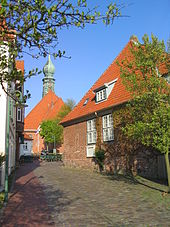St. Bartholomäus (Wesselburen)
The Church of St. Bartholomew is at the highest point in Wesselburen on a Wurt , its characteristic onion dome can still be seen from many kilometers away. She belongs to the Evangelical Luth. Wesselburen parish in the Dithmarschen parish of the Evangelical Lutheran Church in Northern Germany .
Originally probably built in the 12th century, the church burned down in 1736; only the Romanesque-Gothic outer walls remained. The builder Johann Georg Schott, b. 1690 in Vaihingen an der Enz, completely redesigned in 1737/1738. It is a unique Baroque church in the region. Schott integrated the previously isolated round tower and the choir under a large roof reminiscent of a hooded coffin. In the middle is a relatively large roof turret with an onion tip reminiscent of southern German churches. (As early as 1711 he created a roof turret of the same shape on the St. Jürgen church in Heide).
This onion tip is unique in this species in Schleswig-Holstein. In the past, the opinion was often expressed that this should be used to express thanks to the Russian tsarist house: Prince Carl Friedrich, Duke of Holstein-Gottorf , who was also responsible for Dithmarschen, was married to the tsar's daughter Anna Petrovna ; their son Carl Peter Ulrich moved to Saint Petersburg in 1742 and became Tsar Peter III in 1762. The Duke Carl Friedrich selected one of the three submitted drafts and supported the reconstruction of the burned down church ideally and with a large sum of money. In recent times, however, the view has prevailed that the builder based himself on the example of onion domes in southern Germany.
The round tower of the church was framed in bricks as part of the renovation work . Tuff was still used in the old tower , which suggests that it was built before 1200. In the 13th century, tuff was replaced by brick in the region. It is therefore likely that the young parish of Wesselburen already had such a tower in front of the mother church in Weddingstedt - the young community in the extremely fertile Nordermarsch tried to stand out from the mother community at an early stage and managed to do so. In addition, the Wesselburen church is the only one in Dithmarschen with an apse made of field stones smoothed by splitting . At the time, this required rare and expensive metal tools. Apart from the main church in Dithmarsch, the Meldorfer Dom , there is no other evidence of the application of the technology in the region.
An incision over the west side of the choir is copied in the style of the stern of a magnificent baroque ship. The pews are traditionally set up in an eastward direction and oriented towards the altar and pulpit. The altar itself is a copy of the Fredenhagen Altar in Lübeck's Marienkirche, which was damaged in 1942 and dismantled in 1959 . The pulpit was designed by the local craftsman Johann Anton Burmeister, according to Nis R. Nissen it is a good craftsmanship without a touch of genius. (P. 100)
The baptism of the church is particularly noteworthy . The stone baptism probably dates from the second quarter of the 13th century and is therefore younger than the church. It was probably made in Westphalia , to which there were numerous connections via the Hanseatic cities . The reliefs on the main page were chipped off in the course of history. In one of only a few baptisms on the slope there is a representation of the streams of Paradise . They are shown as four men with bare chests, holding both fish and writing aloft. They are recognizable both as water beings (fish) and as heralds of the gospel (scroll). The four rivers of paradise symbolized the four gospels in the imagination of that time, as they drew on ancient ideas that the four rivers give water and life.
Bells
A three-part bell ensemble hangs in the St. Bartholomew Church in Wesselburen. They are made of iron and hang in the newly roofed old church tower stump, which had to be removed a little. They were cast in the 20th century by Ulrich and Weule, probably around 1920, in the so-called sub-nib. In the roof turret of the building hangs an old clock bell whose year of casting is unknown.
1st bell strike: d 'Gießer: Fa. Ulrich and Weule, Vogtland
2nd bell strike: e 'Foundry: Fa. Ulrich und Weule, Vogtland
3rd bell strike: f 'Foundry: Fa. Ulrich und Weule, Vogtland
4th bell / clock bell
Motif: Resurrèxi
Web links
Coordinates: 54 ° 12 ′ 43.8 " N , 8 ° 55 ′ 20.9" E


